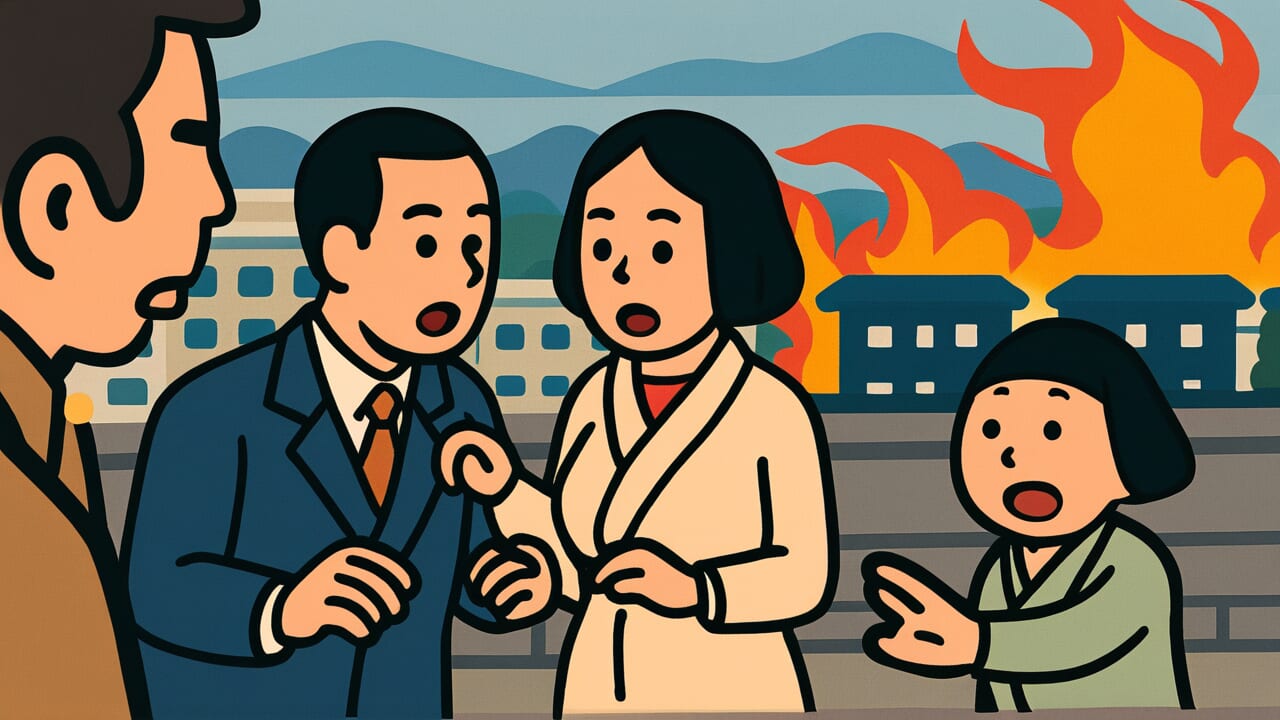How to Read “Fires and fights are the flowers of Edo”
kaji to kenka wa edo no hana
Meaning of “Fires and fights are the flowers of Edo”
This proverb describes how fires and fights happened very frequently in Edo during the Edo period. By using the word “flowers,” it speaks of these normally undesirable events with a touch of irony and pride, treating them as defining features of the city.
People used this expression to explain what made Edo unique. Fires were a daily occurrence because wooden houses were packed tightly together. Fights also never stopped because many hot-tempered craftsmen and merchants lived there.
Today, people sometimes use this saying to describe characteristic events of a particular place or time. The key point is not just about disasters or conflicts. It’s about viewing them as symbols of a place’s spirit and culture.
Origin and Etymology
Edo was a city with fires unlike anywhere else in the world. Wooden houses stood close together, and dry seasonal winds blew strongly in winter. Once a fire started, it spread in an instant.
“Fires and fights are the flowers of Edo” was born from these urban characteristics.
Historical records show dozens of major fires called “taika.” The Great Meireki Fire even burned down Edo Castle’s main tower. Firefighters were the pride of Edo residents. Their brave work at fire scenes became the talk of the town.
Fights were also considered a specialty of Edo. Many hot-tempered craftsmen and merchants lived there. Arguments started over small things and sometimes turned into brawls. Fights among scaffold builders were especially bold and drew crowds of spectators.
The word “flowers” reveals the unique aesthetic sense of Edo residents. They found a kind of beauty and brilliance even in fires and fierce fights. These became symbols of the city’s energy and people’s spirit.
This saying captures the Edo spirit of viewing even difficult situations positively.
Interesting Facts
During the Edo period, firefighters were the dream job of Edo residents. The town firefighters called “Iroha Forty-Eight Groups” were especially famous. Each group rushed to fire scenes competitively. The sight of them waving their standards was magnificent.
Their heroic deeds became theater material and entertained common people.
Edo fights had unique rules. Bare-handed fighting was basic, and using weapons was considered cowardly. There was an unwritten rule not to hold grudges after a fight ended. Acting as if nothing happened the next day was considered stylish for Edo residents.
Usage Examples
- When you read Edo period records, fires and fights really did happen frequently, just as “Fires and fights are the flowers of Edo” says
- Old Edo had some kind of commotion almost daily, as the saying “Fires and fights are the flowers of Edo” suggests
Universal Wisdom
This proverb contains deep wisdom about how humans perceive difficult situations. Fires are disasters. Fights are conflicts. These should be events to avoid and lament.
But Edo people called them “flowers.” This shift reveals humanity’s remarkable adaptability and power to live positively.
When facing unchangeable reality, people can choose two paths. One is to keep lamenting. The other is to accept that reality and find some meaning or value in it.
Edo people chose the latter. Instead of lamenting frequent fires, they praised firefighters’ bravery. They even viewed fights as proof of the city’s vitality.
This attitude is not simple resignation. Rather, it’s an active way of living that accepts situations as part of one’s own story and finds beauty and pride in them.
Humans are beings who create meaning. The same event can change life’s quality depending on how we interpret it.
We who live today also face unavoidable difficulties. At such times, can we find something positive in the situation like Edo residents did? That might determine the richness of our lives.
This proverb still speaks to us as wisdom for living through adversity.
When AI Hears This
Edo had one of the world’s highest population densities. When one million people are packed into limited space, entropy accumulates. This means disorder and scattered energy build up.
Dense wooden buildings trap heat. Friction in human relationships creates psychological pressure. If this energy is left alone, the entire urban system collapses.
What’s interesting is that Edo people made fires and fights function as “release valves.” Fires reset physical overcrowding and created open spaces. Fights made social tensions visible and temporarily released them.
By calling these “flowers,” they culturally accepted what were originally disasters. They positioned them as proof of urban vitality.
Modern urban engineering says systems need “planned instability” to stay stable. For example, completely preventing forest fires causes dead wood to accumulate, eventually causing major disasters.
Edo people understood this through experience. By allowing small fires and fights regularly, they prevented fatal riots and great fires. By giving aesthetic value, people accepted danger and incorporated it into the rhythm of urban life.
This paradoxical wisdom might be exactly what modern cities aiming for perfect control need.
Lessons for Today
This proverb teaches us how to face our environment. We all live in situations we cannot change. Workplace conditions, family circumstances, social systems. Complaints are endless.
But Edo people teach us something. If reality cannot be changed, change how you deal with that reality. Fires and fights can become the city’s character if you change your perspective.
If you’re in a situation you absolutely cannot change, try finding even one positive element in it.
This is not escapism. Rather, it’s an active way of living that looks squarely at reality and gives it your own meaning. If your commute is long, make it reading time. If you have a difficult boss, view it as a chance to observe human nature.
Small shifts in perspective change daily quality.
The “stylish” way of living of Edo residents might be exactly what we need today. Not lamenting difficulties, but making even them “flowers” of your life.
This proverb conveys that strength and flexibility to us.



Comments